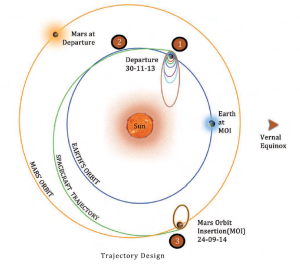India’s Mars Orbiter Mission (MOM), performed the Trans-Mars Injection (TMI) on 1st December, and is off on its long journey towards Mars. The spacecraft has crossed the Moon’s orbit and is now the farthest object India has ever put in Space.
“Then it travels a long path….after travelling roughly 680 million kilometres through this path, it comes closer to Mars … on September 24 of next year 2014,” said V Koteswara Rao, Scientific Secretary at ISRO.
The MOM spacecraft, also known as “Mangalyaan” which means “Mars craft” in Hindi, has a mass of about 1350 kg and was developed in record time – just 18 months. MOM is a technology demonstrator mission with the goal to aid development of the technologies required for design, planning, management and operations of an interplanetary mission.
“We want to use the first opportunity to put a spacecraft and orbit it around Mars,” said K. Radhakrishnan, ISRO Chairman. “And, once it is there safely, then conduct a few meaningful experiments and energize the scientific community.”
MOM launched close on the heels of NASA’s Mars Atmosphere and Volatile EvolutioN (MAVEN), a space probe designed to study the Martian atmosphere while orbiting Mars which launched on 18th November. MAVEN’s mission carries a cost of $672 million, while MOM costs only $70 million for this first modest effort by India.
“We are more application-specific in our approach. So we don’t spend much on research. But this is one of our efforts in exploratory science… India’s modest contribution to the understanding of science,” said ISRO officials.
MAVEN and MOM are intended to study the Martian atmosphere, to understand why the planet’s liquid water was lost, and how the Martian climate was transformed into the cold, dry climate present today.
Orbiting a satellite around Mars is extremely difficult. A little more than 50% of previous missions have failed. If successful, Indian Space Research Organization (ISRO) will the fourth space agency to reach Mars, following by NASA, Russian Space Agency, and European Space Agency.
Below, video of MOM’s launch:
Feature image caption: Launch of Mars Orbiter Mission “Mangalyaan” toward the Mars on a Polar Satellite Launch Vehicle (PSLV) on Nov. 5, 2013 (Credits: Indian Space Research Organisation).







































![A trajectory analysis that used a computational fluid dynamics approach to determine the likely position and velocity histories of the foam (Credits: NASA Ref [1] p61).](http://www.spacesafetymagazine.com/wp-content/uploads/2014/05/fluid-dynamics-trajectory-analysis-50x50.jpg)



Hope for the success!
Can we, public, track Mom? Is there any website like sat view? Most of the websites track only earth orbit satellites. Thanks.
If India’s Mar s probe is cheap it is because the equipment it carries and construction material are surely of inferior quality than the US.
Would India know how to make sophisticated communication and propulsion equipment?
[Why is this comment in upper case only??]
Hello Krishnan,
Thanks for writing. I am not aware about any specific website that lets you track Mars Orbiter Mission, but you can get latest updates about the location from MOM website and Facebook page. Here is the link:
http://www.isro.org/mars/updates.aspx
https://www.facebook.com/isromom
Thanks.
Siddharth Raval
Dear mr.eddie
Isro space programme is cheaper than that of other countries
for many reasons. quality is not compromised at all.deep space communication & accurate position measurement of injected probes
& precision propulsion technology are beyond comment.
Mr Murugan, you say “Quality is not compromised at all”. How do you know? Are you familiar with the manufacture and function of the Indian components or are you just being patriotic?
Have you compared them with the US equipment? the US rover on Mars seems to be a miracle of engineering.
Please list the Indian components and tell us precisely what they do.
MR Eddie,
I guess you have the complete list of US and Indian components used in their respective mars missions. And you have compared them.
And you are also completely aware of all functions of each and every components.
hence i believe you have made such a comment.
Or are you being completely stupid and jealous !!!!
Be a little appreciative.
soon you will see satellite launches being outsourced to india just like information technology.
hahaha edde…. you are really silly ! the cheapest mission doen’t means low quality equipment! it is the idea to put the satellite in a simplest possible and economical way. mangalyaan doent require monster rocket like maven because it takes advantage of centrifugal pull while rotating around the earth. but maven will take its satellite directly with out doing this procedure. also maven require huge quantity of full compared to mangalyaan.